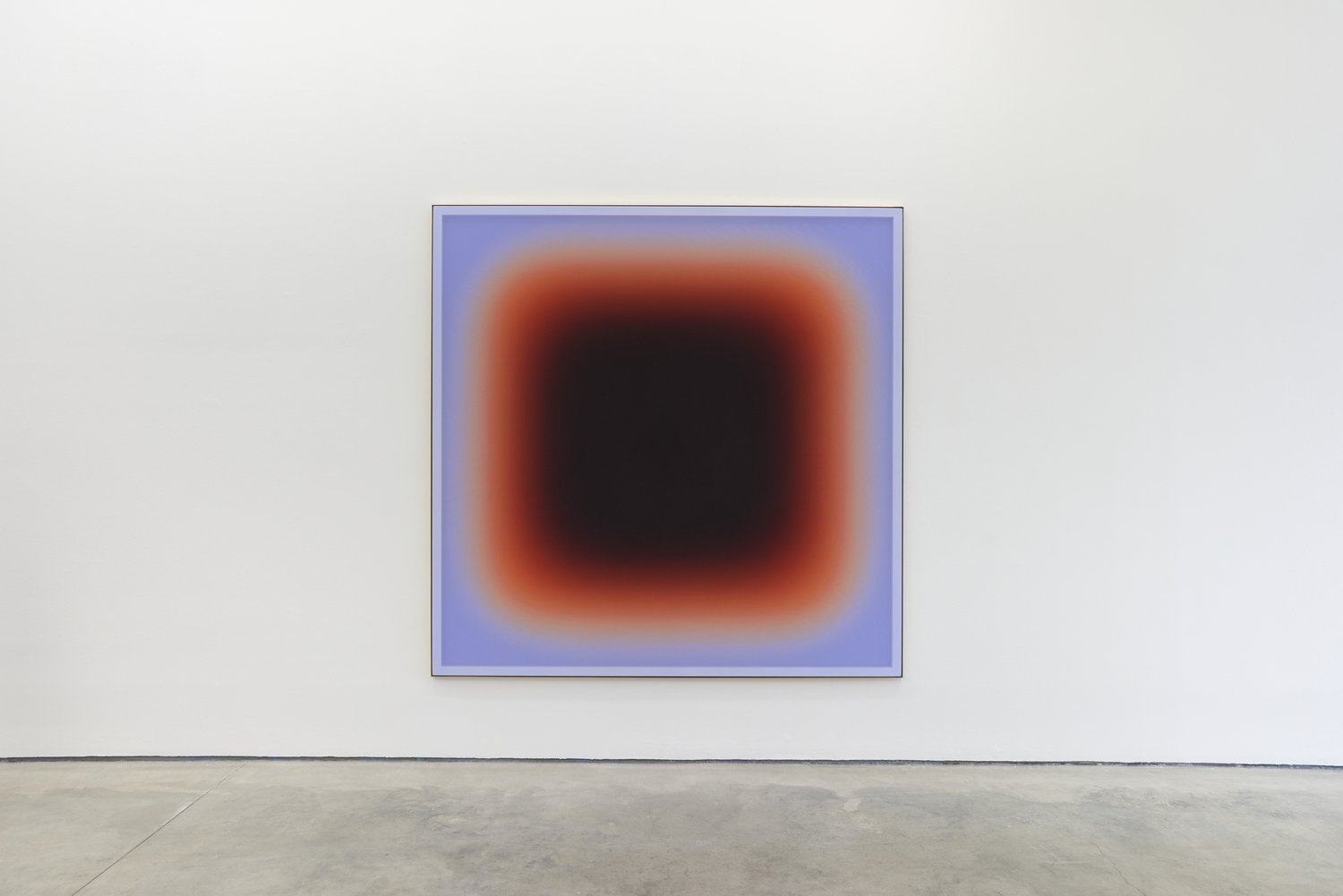
















































Working across an expanded field of painting, sculpture and abstraction, Jonny Niesche’s vividly coloured work wraps the viewer in total sensory stimulation. The seductive, iridescent surfaces of his paintings hum and shimmer with pigment, colour that seems to float slightly above the voile surface. The effect is intensified by the indistinct edges between bands of colour that surround the dark middle ground. As one tone blurs and dissolves into the next, a silky insubstantiality of pure colour and sensation emerges. Niesche has long worked with the intrinsic relationship between colour, form and light to produce formal and optically charged works that challenge our perception of space. His painting offers a transformative formal beauty that is beguiling. The glowing neon tones and soft pastels that flow from a mysterious dark centre are finished with reflective gold rims, mirroring the viewer back to his or her self in a surprising encounter with the artwork.
Niesche’s practice draws widely for its influences, including formal elements from twentieth-century art and the shiny allure of popular culture. He has exhibited a series of articulated screens filled with tonal gradients taken from the cover of David Bowie’s album Aladdin Sane. The shades of Debbie Harry’s 1970s make-up have also entered his work, Niesche combining the best of disco’s theatrical, decadent aesthetic with a detached minimalism. These reductive forms that vibrate with the energy of vivid colour are often set against metal and mirror, offering shifting, alluring experiences of form, space, and movement. Materially fetishistic, glitter, mirror, translucent custom-dyed fabrics, and steel combine to offer a glamorous urban beauty. Recent exhibitions have seen Niesche produce art works of multiple panels that stretch up the gallery wall. Beginning intensely and moving progressively through lighter tints, the multi-panelled paintings become wall-based 3-dimensional forms. Soft mint greens join other works where gradients of neon pastels—electrically charged turquoise blues fading into striking fuchsias—conjure up Miami sunsets, cocktails, and carefree tropical warmth.
Jonny Niesche
MirrorMirror: The Reflective Surface in Contemporary Art, written by Michael Petry, is a dazzling and intriguing exploration of the use of mirrors and reflective surfaces as a medium in global contemporary art.
From the art of Cindy Sherman to Anish Kapoor, from Yayoi Kusama to Tracey Emin, MirrorMirror presents an intriguing and gloriously illustrated global survey of “reflective” work by more than 150 artists across media, nationalities, genders, and locations.
A fascination with mirrors and reflective surfaces is a common theme among artists of the past. Michael Petry’s thought-provoking introduction begins with Jan van Eyck’s celebrated Arnolfini Portrait (1434), one of the first paintings to feature a significant mirror. Petry references key works by the great masters—from Diego Velázquez’s The Rokeby Venus (1647–1651), to Édouard Manet’s complex painting A Bar at the Folies-Bergère (1882), and Claude Cahun’s Reflected Image in Mirror, Checked Jacket (1928), a seminal photograph for those whose gaze is often upon themselves.
Present-day practitioners are no less intrigued, revisiting historical concerns and approaches for contemporary circumstances, often working with modern technologies and materials. Petry presents Jeff Koons’s Balloon sculptures, Subodh Gupta’s stainless-steel life-sized trees, and Not Vital’s mirror architecture, and documents works that use actual mirrors, including pieces by Gavin Turk, Jonny Niesche, and Alicja Kwade, and the largescale, spectacular installations of Doug Aitken, Teresita Fernández, Olafur Eliasson, and Sarah Sze. Special consideration is given to selfies and the way in which the cellphone now operates as a modern-day mirror to the self.
The multitude of artworks in MirrorMirror—from monumental installations to the slightest selfie—capture how mirrors appeal to more than just human vanity but are objects of magic, transformation, and power.
Published by Thames & Hudson
Hardcover
288 Pages
9.4 in x 11.1 in x 1.2 in
ISBN: 9780500026205
Jonny Niesche
Cracked Actor: Works 2013-2018
Jonny Niesche’s fascination with colors, mirrors and glitter began back in his childhood in the early 1980s when he and his mother visited the cosmetics section of a department store in Sydney. In the geometrically abstract works by the Australian artist created from 2013 to 2018 and documented in this publication, the aesthetic aspect of the materials used plays a major role. Niesche works with flat, polished, mirrored surfaces, welded steel fittings, fabrics in soft pastel tones, and creates meditative image-objects in which sculptural and pictorial tendencies are combined. In his works based on color and light, the artist experiments with processes of visual perception. Through the glittering and mirroring surfaces, the works involve the viewer? and in this regard Niesche’s objects and installations are reminiscent of American Minimal Art and artists such as Larry Bell, Donald Judd and John McCracken. Furthermore, Niesche’s artistic production is rich in references to the Glam Rock of the 1970s, most notably David Bowie or Debbie Harry.
Author: Magdalena Zeller
Editor: Magdalena Zeller
Publisher: Verlag für Moderne Kunst, 2018
ISBN: 3903269379, 9783903269378
Length: 136 pages